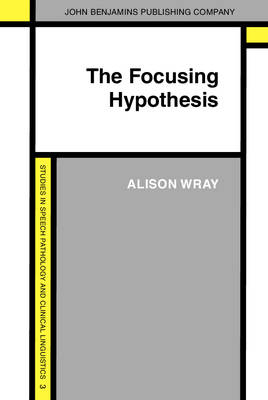
The Focusing Hypothesis
John Benjamins Publishing Co (Verlag)
978-90-272-4333-1 (ISBN)
This book explores the nature of the control of language processing by the hemispheres of the neocortex. The author expounds a novel hypothesis, “The Focusing Hypothesis”, which holds that language processing in the brain is achieved through analytic and holistic systems, the former through left and the latter through right hemisphere processing. This hypothesis differs from current thinking in so far as it proposes that the involvement of the two systems (and two hemispheres) depends on the strategy selected by the speaker and that the engagement by one hemisphere over another will depend upon the communicative intent of the speaker and the propositionality of the utterance under production.
Throughout the book there are useful and important discussions on such topics as the value of laboratory-based psycholinguistic experiments — given their tendency to encourage a “metalinguistic” strategy on the part of subjects, the nature of propositionality in language and brain and the difficulties of testing this hypothesis given the research approaches currently available.
The Focusing Hypothesis is tested by comprehensive review of the existing experimental psycholinguistic, neuropsychological and neurophysiological literature, and a range of predictions which follow from the hypothesis are detailed.
1. Foreword; 2. Notes on Terminology; 3. Introduction; 4. Chapter One: The Focusing Hypothesis; 5. 1.1 Defining Terms; 6. 1.2 The Dynamic Relationship of the Two Systems; 7. 1.3 Juxtaposition; 8. 1.4 Proposition-Focused Language (PFL) and Language-Focused Language (LFL); 9. 1.5 A Brief Justification for Holistic Language Processing; 10. 1.6 The Operation of the Holistic Mechanisms; 11. 1.7 Formulae in Language Processing; 12. 1.8 The Acquisition of Formulae; 13. 1.9 Strategies; 14. 1.10 The Right and Left Hemispheres; 15. Notes to Chapter One; 16. Chapter Two: Theoretical Issues; 17. 2.1 Introduction; 18. 2.2 Terminology; 19. 2.3 The Reduction of Juxtapositional Complexity; 20. Notes to Chapter Two; 21. Chapter Three: Support for the Structure of the Focusing Hypothesis; 22. 3.1 Introduction; 23. 3.2 Dual Systems; 24. 3.3 Optimal Processing; 25. 3.4 Holistic Processing; 26. 3.5 Strategies; 27. 3.6 Clausal Processing: Challenge and Support; 28. 3.7 Summary; 29. Notes to Chapter Three; 30. Chapter Four: Experimental Psycholinguistic Studies; 31. 4.1 Introduction; 32. 4.2 Dichotic Listening Tests; 33. 4.3 Problems with the Dichotic Listening Test; 34. 4.4 Tachistoscopic Tests; 35. 4.5 Verbal-Manual Interference Tasks; 36. 4.6 Lateral Eye Movement; 37. 4.7 Comments; 38. 4.8 Prediction: Language Focus in Experiments; 39. 4.9 The Scope for Controlling Focus in Experiments; 40. 4.10 The Value of Psycholinguistic Date in Evaluating the Focusing Hypothesis; 41. Notes to Chapter Four; 42. Chapter Five: Clinical Investigations; 43. 5.1 Introduction; 44. 5.2 Left Hemisphere Lesion; 45. 5.3 The Role of the Right Hemisphere in Language; 46. 5.4 Inconsistencies in the Clinical Data; 47. 5.5 Prediction: Disruption to the Processing Mechanisms of Left-Hemisphere-Damaged Patients; 48. 5.6 Prediction: Disruption to the Processing Mechanisms of Right-Hemisphere-Damaged Patients; 49. 5.7 Prediction: The Token Test; 50. 5.8 Prediction: The Effect of the Right Hemisphere Processing of Emotional & Intonational Cues on Beginner Readers & on Left- and Right-Hemisphere-Damaged Patients; 51. 5.9 Summary and Comments; 52. Notes to Chapter Five; 53. Chapter Six: Neurophysiological Investigations; 54. 6.1 Introduction; 55. 6.2 Anatomy; 56. 6.3 Dynamic Studies; 57. 6.4 Prediction: Detecting Right Hemisphere Activity; 58. Note to Chapter Six; 59. Chapter Seven: Towards a Model for Output; 60. Notes to Chapter Seven; 61. Chapter Eight: Evaluating the Hypothesis; 62. Note to Chapter Eight; 63. Appendix; 64. Bibliography; 65. Index
| Erscheint lt. Verlag | 12.11.1992 |
|---|---|
| Reihe/Serie | Studies in Speech Pathology and Clinical Linguistics ; 3 |
| Verlagsort | Amsterdam |
| Sprache | englisch |
| Maße | 164 x 245 mm |
| Gewicht | 420 g |
| Themenwelt | Geisteswissenschaften ► Philosophie ► Sprachphilosophie |
| Geisteswissenschaften ► Sprach- / Literaturwissenschaft ► Sprachwissenschaft | |
| Medizin / Pharmazie ► Medizinische Fachgebiete ► Neurologie | |
| ISBN-10 | 90-272-4333-6 / 9027243336 |
| ISBN-13 | 978-90-272-4333-1 / 9789027243331 |
| Zustand | Neuware |
| Haben Sie eine Frage zum Produkt? |
aus dem Bereich


